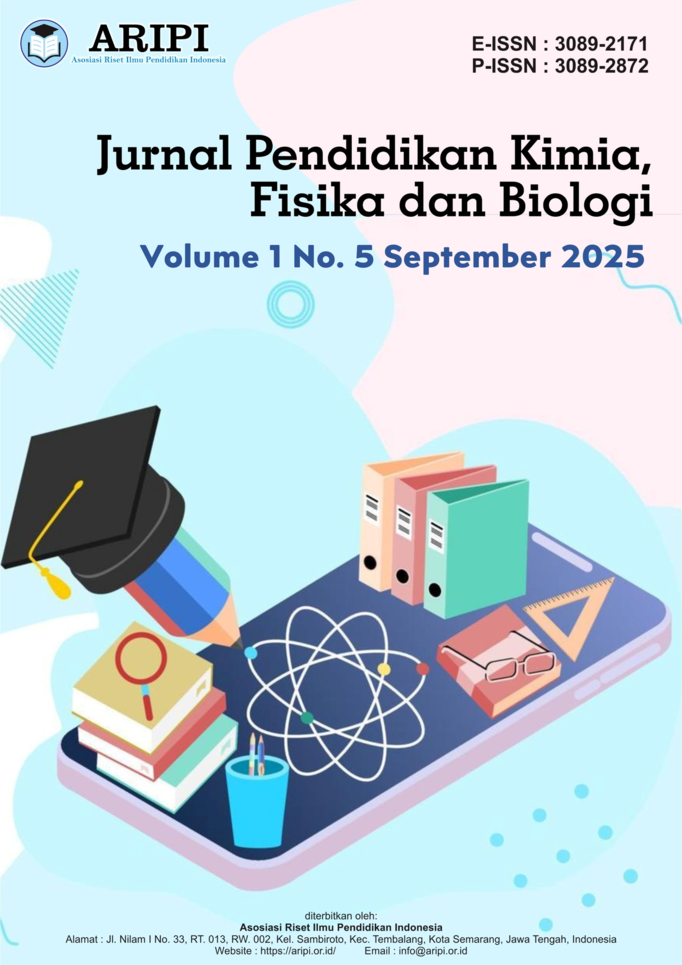Metode Penelitian Ilmiah Karakteristik dan Potensi Bakteri Asam Laktat (BAL) pada Makanan Khas Melayu (Tempoyak) sebagai Agensi Probiotik
DOI:
https://doi.org/10.61132/jupenkifb.v1i5.609Keywords:
Fermentation, Lactic Acid Bacteria, Probiotics, Tempoyak, Traditional FoodAbstract
Cell-based therapy is an innovative approach currently experiencing rapid development in the biomedical field, particularly in the areas of immunotherapy and gene therapy. This approach utilizes living cells, such as genetically modified T cells, to recognize and destroy abnormal cells such as cancer cells or cells with genetic mutations. The development of gene engineering technologies, such as CRISPR/Cas9, has enabled scientists to precisely edit damaged genes, thereby repairing or restoring normal cell function. This study aims to examine recent advances in cell-based therapy, focusing on cell modification techniques, the efficiency of the immune system in targeting cancer cells, and the integration of gene therapy technology and immune cells. Furthermore, this study also identifies several challenges that remain, including the risk of side effects due to undesirable immune reactions, the genetic stability of the modified cells, and the long-term sustainability or viability of transplanted cells. While these challenges remain serious concerns, several clinical studies have shown that cell-based therapy has significant potential in the treatment of difficult-to-treat diseases, such as advanced cancer and rare genetic disorders. The results of this study demonstrate that cell-based therapy not only offers a new approach to treatment but also opens the door to more personalized and precise therapies. However, for broader implementation in clinical practice, further, in-depth research is needed regarding safety, long-term efficacy, and strict regulation. This research is expected to make a significant contribution to the development of more effective and safe future therapies.
References
Abbott Family. (2023). 9 manfaat probiotik untuk kesehatan, terutama pencernaan. https://www.family.abbott
Alodokter. (2023). Probiotik: Kenali jenis bakteri dan manfaatnya. https://www.alodokter.com/probiotik-kenali-jenis-bakteri-dan-manfaatnya
Ardilla, A., Anggreini, K. W., & Rahmani, D. P. (2022). Peran bakteri asam laktat indigen genus Lactobacillus pada fermentasi buah durian (Durio zibethinus) untuk produksi tempoyak. Jurnal Bioteknologi dan Industri Pertanian, 13(1), 42-52. https://doi.org/10.22146/bib.v13i2.4619
Dewi, M. A., Mubarik, N. R., Desniar, & Budiarti, S. (2022). Aplikasi bakteri asam laktat dari inasua sebagai biopreservatif ikan patin. Jurnal Hasil Pengolahan Perikanan Indonesia, 25(1), 152-162. https://doi.org/10.17844/jphpi.v25i1.39206
FAO/WHO. (2002). Guidelines for the evaluation of probiotics in food. https://www.fao.org/3/y6398e/y6398e.pdf
Halodoc. (2023). Hal yang perlu dipahami seputar bakteri asam laktat. https://www.halodoc.com/artikel/hal-yang-perlu-dipahami-seputar-bakteri-asam-laktat
Ismail, Y. S., Laila, C. A., Iqbar, I., & Ananda, Z. (2025). Isolasi dan identifikasi bakteri asam laktat (BAL) pada fermentasi buah durian (jruek drien). Jurnal Bioleuser, 9(1), 1-3. https://doi.org/10.24815/bioleuser.v9i1.44377
Mardalena. (2016). Fase pertumbuhan isolat bakteri asam laktat (BAL) tempoyak asal Jambi yang disimpan pada suhu kamar. Jurnal Sain Peternakan Indonesia, 11(1), 58-66. https://garuda.kemdikbud.go.id/documents/detail/1181844 https://doi.org/10.31186/jspi.id.11.1.58-66
Muzaifa, M., Moulana, R., Aisyah, Y., Sulaiman, I., & Rezeki, T. (2017). Karakteristik kimia dan mikrobiologis asam drien (durian fermentasi) dari Aceh pada berbagai metode pembuatan. Agritech, 37(2), 93-98. https://doi.org/10.22146/agritech.### (Lengkapi DOI jika tersedia)
Najah, N., Manalu, K., & Amelia Nst, R. (2023). Karakteristik dan potensi bakteri asam laktat (BAL) pada makanan khas Melayu (tempoyak) sebagai agensi probiotik. Jurnal Biolokus: Jurnal Penelitian Pendidikan Biologi dan Biologi, 6(2), 331-337. https://doi.org/10.52121/biolokus.v6i2.7481
Nizori, A., Prayogi, N., & Mursalin. (2017). Isolasi dan identifikasi bakteri asam laktat tempoyak asal Jambi dari berbagai konsentrasi garam. Dalam Prosiding Seminar Nasional FKPT-TPI 2017 (hlm. 408-415). Kendari, Sulawesi Tenggara, 20-21 September 2017.
Permatasari, I., Turnip, M., & Kurniatuhadi, R. (2022). Isolasi dan karakterisasi bakteri asam laktat pada tempoyak durian pekawai (Durio kutejensis (Hassk.) Becc.). Agroprimatech, 6(1), 7-15. https://doi.org/10.31294/agroprimatech.v6i1.11098
Yulvizar, C., Ismail, Y. S., & Maoulana, R. (2015). Karakterisasi bakteri asam laktat indegeneous dari jruek drien, Provinsi Aceh. Jurnal Teknologi dan Industri Pertanian Indonesia, 7(1), 31-39. https://doi.org/10.17969/jtipi.v7i1.2831
Yunita, A. A., Anggreini, K. W., & Tara, P. D. R. (2022). Peran bakteri asam laktat indegen genus Lactobacillus pada fermentasi buah durian (Durio zibethinus) sebagai bahan pembuatan tempoyak. Berkala Ilmiah Biologi, 13(2), 42-52. https://doi.org/10.22146/bib.v13i2.4619
Yunita, A., Ayu, A., Anggreini, K. W., Puri, T., & Rahmani, D. (2022). Peran bakteri asam laktat indigen genus Lactobacillus pada fermentasi buah durian (Durio zibethinus) sebagai bahan pembuatan tempoyak. Jurnal Bioteknologi dan Industri Pertanian, 13(1), 42-52. https://doi.org/10.22146/bib.v13i2.4619
Downloads
Published
How to Cite
Issue
Section
License
Copyright (c) 2025 Jurnal Pendidikan Kimia, Fisika dan Biologi

This work is licensed under a Creative Commons Attribution-ShareAlike 4.0 International License.





